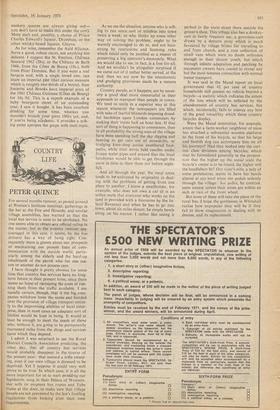Pamela VANDYKE PRICE
Gastronomy abounds in old wives' tales: cheese at bedtime gives you bad dreams, port and champagne at the same meal gives you a hangover, women shouldn't walk through mushroom caves at certain times of the month, when they can't make mayon- naise anyway.... The lot are untrue, though the more backward mushroom cave keepers do tend to keep women out, t believe.
But one old saw has stuck longer than most—the assertion that single malt whisky is 'too strong, too heavy, too definite, too heady' to be drunk except on the moor, up the glen or alongside the loch. Now single malts are, in a vague way, the first-growth clarets of Scotland: each is an individual whisky, with the characteristics of its region and pot still. The malts of, say, Speyside are different from the Campbeltowns or !slays, varying according to what they are as the great bulk of whiskies, products of the patent or continuous still, and blends in which a certain proportion of malt is bound to be included, can never do. You buy 'scotch' in general according to the brand you like, you use it straight or in mixes, You buy single malt because of the distillery you prefer and you drink it—ideally—only with the addition of water, Malvern if you're remote from Loch Katrine.
The first time I was introduced to single malt I admit I was cautious. (I am not one for uncomfortable and only supposedly health-giving outdoor exercise of any sort). Would the tasting of fourteen single malts
to which 1 was invited by the Scotch Whisky Association prove too much of a strain? It merely resulted in my deciding that certain malts appealed to me more than others (at least then) and in my now filling my travel-
ling flask with malt instead of brandy, because whereas you can almost always get some sort of brandy, there are times when you want a sound strong drink, either by way of talking point to share with the fascinating character marooned with you at an airport, or else to offer to bandit chief or foreign wine potentate for diplomatic and strategic reasons—and single malt is still something of a, special treasure. Another relevant old wives' tale is that of never mixing grape and grain—obviously you don't stun your palate with spirits before attempting to appreciate fine wines, but a single malt is a wonderful digestive after a good dinner and, with its special elegance and character, I think it can even come closer to the meal than that. I was once asked to arrange a luncheon for William Grant, who love fine wines as much as they do good scotch, and we had champagne as the aperitif, then a hot consommé of beef, followed by the kipper pâté which the Con- naught Hotel say they mix with a little scotch anyway, and which on this occasion was accompanied by a small glass—straight —of Grant's Glenfiddich. I certainly didn't hear any comments that this spoiled the white burgundy and the two clarets that we went on to drink.
If you still feel—as an effete southerner— that starting on malt is rather like Alice when confronted with 'Drink Me', then you might begin with Haig's Glenleven, which is a vatting of six single malts, very smooth and aromatic. Otherwise, Peter Dominic, who put up a sampling pack of twelve malts (75s) in large miniatures enable you to do a selective tasting for yourself. It is fair com- ment to say that the Islay malts, of which Laphroaig is the most famous, and the Skye malt, Talisker, are so very distinctive in flavour (some people call them 'peaty') that you may not like them at first, but there are plenty of others; my own favourites at present, in addition to Glenfiddich, are the Orkney malt, Highland Park, very vivacious. somehow outstandingly charming, Johnnie Walker's Speyside Cardhu, and Smith's The Glenlivet (entitled to call itself thus as the result of a court case).
As the haggis are flying low the noo- and existence in the strike-threatened, bill- sodden, transport-complicated south is quite as strenuous as in Highland or Island, you could sustain yourself with the sort of meal that was planned to defy the elements in the north.
• A single malt, with water, by way of aperitif, may be followed by either cock-a- leekie soup or kipper pâté (or both) then haggis (Selfridges have good ones if you lack a source of supply north of the border). If you balk at the traditional bashed neeps, then spring cabbage is excellent. End with Dunlop cheese (accent on the last syllable to show you're not referring to the tyre) and perhaps the oatmeal-rolled cream cheese. Caboc, and then a syllabub (a tip; as the
cookery •queens are always giving out— you don't have to make this under the cow). More malt and, possibly, a choice of Prince Charles Edward's liqueur, Drambuie, or the other whisky-based liqueur, Glayva.
As for wine, remember the Auld Alliance. Serve a good, robust claret, not anything too delicate. I suggest the St. Emilion, Château Soutard 1962 (28s), or the Château de Barb 1966, from the Crites de Bourg (18s.), both from Peter Dominic. But if you want a real bargain and, with a single loved one, can share an imperial pint (that curious measure which is roughly two-thirds of a bottle), then Justerini and Brooks have imperial pints of the 1961 Château Guionne (Cotes de Bourg) for 16s 9d. This is a superb example of a baby bourgeois claret of an outstanding year. I saw it bought, it has been excellent drinking for some time, whereas you shouldn't broach your great 1961s yet, and, if you're being academic, it provides a talk- ing point apropos the grape with malt topic.











































 Previous page
Previous page